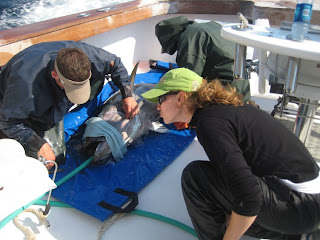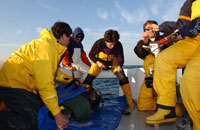 Colors show the expected probability of catching bluefin tuna in the Gulf of Mexico based on fisheries data and tagging studies (red is high probability, blue is low). Illustrates discrete bluefin tuna spawning hotspots in the eastern and western GOM.
Colors show the expected probability of catching bluefin tuna in the Gulf of Mexico based on fisheries data and tagging studies (red is high probability, blue is low). Illustrates discrete bluefin tuna spawning hotspots in the eastern and western GOM.
This is especially important for bluefin tuna, whose numbers have declined to less than 20% of what they were just a few decades ago. If we can improve management of the “western stock,” which breeds in the Gulf of Mexico (as opposed to the “eastern stock” that breeds in the Mediterranean), this would be a significant step for the population as a whole.
Unfortunately, the implications of the paper also carry a downside for bluefin, in light of the current situation in the Gulf. It appears that one of the key breeding grounds, in the eastern Gulf of Mexico, is currently being impacted by the Deepwater Horizon oil spill. We don’t know what effect this will ultimately have on the spawning tuna or their offspring, but we have been working in the lab on how to measure stress genomically and we hope to move forward applying some of the work to the Gulf of Mexico tuna populations. We are currently collaborating with scientists from other labs in the Gulf region to investigate these questions further.
Visit http://www.tagagiant.org/PLoS_GOM_5.28.10.shtml to learn more about the paper.
Friday, May 28, 2010
New TAG study maps bluefin spawning habitat in the Gulf of Mexico
Tuesday, May 4, 2010
Hot Tuna and Oil: Bluefin in the Gulf off Mexico
At a time when our Gulf of Mexico bluefin stock is vitally important to protect, where every last fish that makes it out of the Gulf is vital to the future of this fishery, when it is imperative they spawn without disturbance, an oil spill happens.
Atlantic bluefin tuna are comprised of several populations and the bluefin that gets the largest are from the Gulf of Mexico spawning stock. Over the past three years we’ve been working in Canada to tag the largest fish- to see where the bluefin spawn. From analyzing fish carrying electronic tags we have learned these “Canadian” bluefin go often to the region just north of the Loop current right where the shelf break occurs (see track below). Here on the frontal edge of the Loop Current, the bluefin spawn- leaving their eggs to hatch into larvae. They require warm temperatures and spectacularly clean water. Unfortunately where the oil spill is occurring is essential bluefin spawning habitat. These are places that are the most important in our waters to protect.
 Map shows the track from an 8-1/2 foot long Atlantic bluefin tuna tagged off Nova Scotia that swam into the Gulf of Mexico, spent several weeks in the spawning area, then departed (yellow track). The dark blob off Louisiana is the estimated coverage area of the oil spill as of May 3.
Map shows the track from an 8-1/2 foot long Atlantic bluefin tuna tagged off Nova Scotia that swam into the Gulf of Mexico, spent several weeks in the spawning area, then departed (yellow track). The dark blob off Louisiana is the estimated coverage area of the oil spill as of May 3.
Our TAG team spent five years working in the Gulf of Mexico, trying to establish the critical spawning habitat for this species - one of the largest fish in the sea. We saw the seismic boats from several companies out on the shelf break searching with sound for oil. Blasting right where the tuna were spawning. It bothered me back then and I told the head of NOAA about the problem (Dr. Rollie Schmitten). I often wondered if they (the oil companies) had an environmental impact statement that included the bluefin tuna. In these waters not only are bluefin spawning, but many other large pelagics as well- blue marlin, swordfish, and later in the spring, yellowfin tuna. Springtime is a time of renewal in the Gulf of Mexico. This place is the fertile nursery grounds to America’s North American fisheries- so the pain may reach far beyond the shores of Louisiana. For the future of the Atlantic bluefin in North American waters, let’s hope that BP and the Federal government act quickly to shut down the leaks.
-Dr. Barbara Block
Monday, May 3, 2010
TAG Gets the Job Done in NC
Thanks to TAG scientists Dr. Andre Boustany and Robbie Schallert for their hard work on and off the water to make the 2010 NC campaign a success. Implanting 52 tags is a major feat so hats off to Andre and Robbie for having the skill and stamina to get the job done. Thanks also to Heather Kerkering and the countless Duke students who reeled in fish and assisted on deck. And an extra special thanks to Captain Dale Britt of the F/V Sensation and his mate Alan for yet another year on the tagging team in NC - your bluefin fishing expertise makes this all possible!










